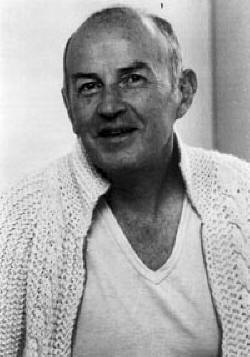

Queer Places:
Antwerpen Schoonselhof Communal Cemetery
Antwerp, Arrondissement Antwerpen, Antwerp (Antwerpen), Belgium
 Karel August Goeyvaerts (8 June 1923 – 3 February 1993) was a Belgian composer.
In the
twentieth century, in the wake of the first waves of homosexual liberation
movemens, composers became more open about their private lives. A number
of European composers were reputedly gay, including
Maurice Ravel,
Reynaldo Hahn,
Karol Szymanowski, and
Francis Poulenc; the
avant-garde had a huge share of gay composers, including
Wolfgang Fortner,
Hans Werner
Henze, Sylvano Bussotti,
Peter Maxwell Davies,
Karel Goeyvaerts,
Jean
Barraqué, Konrad Boehmer, and
Pierre Boulez. English composers who were
reputedly gay include Roger
Quilter,
John Ireland,
George Butterworth,
Arthur
Benjamin, Eugene Goosens, and
Noël Coward; two of the most important
English composers, Benjamin Britten and
Michael Tippett, both achieved
particular notoriety for being openly gay (although each handled it very
differently).
Karel August Goeyvaerts (8 June 1923 – 3 February 1993) was a Belgian composer.
In the
twentieth century, in the wake of the first waves of homosexual liberation
movemens, composers became more open about their private lives. A number
of European composers were reputedly gay, including
Maurice Ravel,
Reynaldo Hahn,
Karol Szymanowski, and
Francis Poulenc; the
avant-garde had a huge share of gay composers, including
Wolfgang Fortner,
Hans Werner
Henze, Sylvano Bussotti,
Peter Maxwell Davies,
Karel Goeyvaerts,
Jean
Barraqué, Konrad Boehmer, and
Pierre Boulez. English composers who were
reputedly gay include Roger
Quilter,
John Ireland,
George Butterworth,
Arthur
Benjamin, Eugene Goosens, and
Noël Coward; two of the most important
English composers, Benjamin Britten and
Michael Tippett, both achieved
particular notoriety for being openly gay (although each handled it very
differently).
Goeyvaerts was born in Antwerp, where he studied at the Royal Flemish Music Conservatory; he later studied composition in Paris with Darius Milhaud and analysis with Olivier Messiaen. He also studied ondes Martenot with Maurice Martenot, who invented the instrument.[1] In 1951, Goeyvaerts attended the famous Darmstadt New Music Summer School where he met Karlheinz Stockhausen, who was five years younger. Both were devout Catholics and found ways of integrating religious numerology into their serial compositions. They found themselves deep in conversation, and performed a movement from Goeyvaerts's "Nummer 1", Sonata for Two Pianos, in the composition course by Theodor Adorno there. They were both astonished upon hearing for the first time Messiaen's "Mode de valeurs et d'intensités" (from Quatre études de rythme), in a recording by the composer which Antoine Goléa played at a lecture. These experiences together convinced Stockhausen he should study with Messiaen. Goeyvaerts became very excited in 1952 when he learned that Stockhausen had access in Paris to a generator of sine waves. Goeyvaerts saw them as an important discovery for music: the purest sound possible. At the time, Stockhausen did not share his enthusiasm, owing partly to the inability with the equipment at hand to superimpose sine tones. Only later, after taking up his new post at the NWDR Electronic Music Studio in Cologne, did Stockhausen find more suitable equipment, in July 1953.[2] One of the first works produced there was Goeyvaerts's Nr. 5 with Pure Tones, which Stockhausen helped his friend to realize. (When Stockhausen seemingly abandoned his work with sine waves and returned to writing compositions for solo piano, Goeyvaerts felt that Stockhausen was abandoning an important discovery and took up the matter from a philosophical point of view himself.) There has been some controversy about who wrote the first European "total" serial composition. His Nummer 2 (1951) for 13 instruments is one of the contenders,[3] as is his Nummer 1 (1950) Sonata for Two Pianos, and the Sonata for Two Pianos by Michel Fano (1950), depending on definitions of "total serialism".[4] After withdrawing from the musical world for a while, he accepted a position in 1970 at the Institute for Psychoacoustic and Electronic Music (IPEM) in Ghent, which led to several other prestigious appointments in Belgium. His works from after 1975 take on aspects of minimalism, the best-known examples being his series of five Litanies (1979–82) and his final work, the opera Aquarius (1983–92). Though minimalism is ordinarily thought of as a reaction against serialism, for Goeyvaerts both techniques were merely subcategories of a non-dynamic, "static music".[5] Analyses of his early serial compositions (especially the electronic Nr. 4, met dode tonen [with dead tones] and Nr. 5, met zuivere tonen [with pure tones]) reveal how close the connections actually are.[6] Goeyvaerts died suddenly in 1993 in his home city of Antwerp.
My published books: